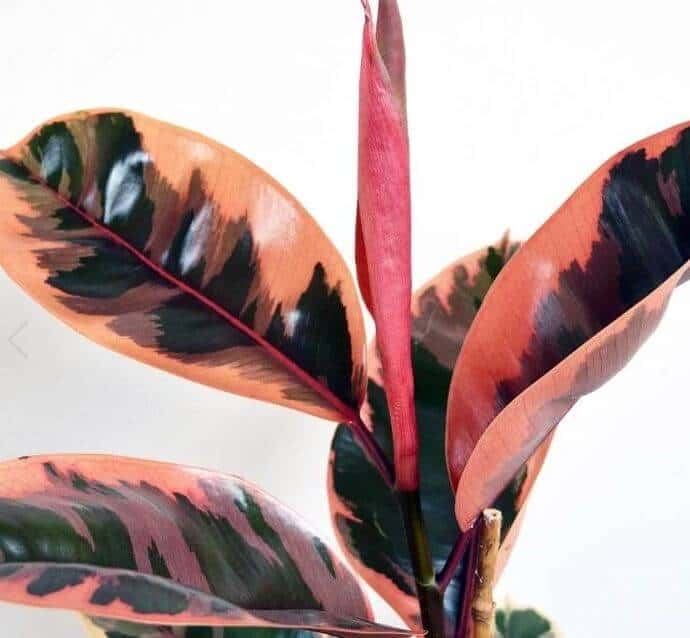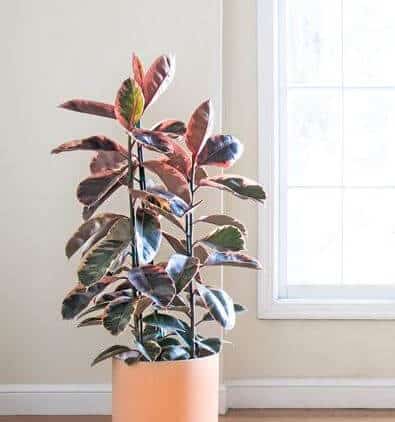Last Updated on January 20, 2023 by a Friendly Gardener
If you’re looking for a cute houseplant to brighten up a room or add to your indoor garden, take a look at the Pink Rubber plant. An easy plant to care for, it can add some spunk or femininity to a bathroom, bedroom, or home office for starters.
This variety of rubber plant is considered a pink variegated rubber plant. Botanically named the Ficus elastica and belonging to the Ficus family, it boasts unique pink leaves with prominent veining. It finds its native habitat in tropical forests between Indonesia and India, and in fact, is often referred to as an Indian Rubber tree.
Pink Rubber Plant Care

An incredibly easy plant to care for, it’s great for beginners and will make any plant enthusiast look as though there’s a green thumb behind this lovely ornamental.
Soil
The most important characteristic of the proper soil for cultivating a Pink Rubber plant is that it drains really well. A quality potting mix is fine, but it’s wise to add in some perlite, coarse sand, or similar to increase drainage capabilities. Looser soil will also benefit the aeration of roots allowing oxygen to penetrate. Ideally, soil pH should be slightly acidic and measured between 5 and 7 for best results.
An ideal pot will be a clay or terra cotta container with drainage holes as this will help wick away any excess moisture.
Light
The pink rubber plant, like the majority of houseplants, requires generous, bright indirect sunlight to thrive. This ficus variety will not manage direct exposition to sunlight which will scorch foliage, but it still needs a good daily dose of light. Without sufficient light, foliage may turn yellow, and growth will suffer. A room with several windows or a large picture window will do nicely. Place the plant near the light source but not directly in the window if the sun is harsh, especially in the afternoons. If you need to place it in a window, make sure there is a sheer curtain to protect the plant. North-facing windows may be sufficiently safe for a window perch.
If your home or office does not have direct light from windows, consider using a grow light. Or you can use fluorescent or LED lights if these are on approximately 16 hours per day. Your plant will also need a period of darkness to rest.
Water

When the soil bed’s top 2 to 3 inches are dry, it’s time to water your plant. Either stick your finger in the pot to feel the soil’s dampness or use a moisture meter. Use filtered or distilled tepid water for the Pink Rubber plant. Water the plant at the base directly into the soil bed and wait for excess water to drain from the drainage holes before returning the plant to its favorite spot.
Avoid using cold water and tap water that contains salts and contaminants. If you must use tap water, leave a bowl out overnight for the chlorine to evaporate before giving it to the plant.
Humidity
Rubber trees need at least 40% to 50% room humidity. Never drier! If the location selected for your plant has higher humidity levels, like a kitchen or a steamy bathroom, all the better.
If you need to improve humidity levels, group several plants together to create a micro-climate, or use a pebble humidity tray underneath the plant’s container. You can mist occasionally, but don’t exaggerate to avoid encouraging fungus infections on foliage. Small space humidifiers are also a great option for houseplants in general.
Temperature
Most home and office temperatures are conducive to this plant’s well-being. Room temps measuring between 60° and 70° F are perfect for healthy plant growth. Rubber plants do not like sudden temperature changes, so keep this in mind when finding the perfect spot for your plant. If temperatures are too chilly, the plant risks experiencing cold shock and will cease to grow. You may want to void open windows at nighttime and do keep an eye on temps if you use air conditioning in the summer.
If you want this plant for a porch, deck, or patio, consider moving it inside after sunset. Expect your pink rubber plant to need about a month to acclimate to its new environment.
Feeding

The pink rubber plant will appreciate being fed regularly, so plan on fertilizing once weekly during the growing season or from spring through the end of summer. A liquid ornamental plant fertilizer that is rich in phosphorous is recommended and should be diluted or applied after the plant has been watered. Another option is to use slow-release fertilizer pellets that will provide nourishment for weeks.
Pruning

You should plan on removing dead or damaged foliage from your Pink Rubber plant because the plant will channel energy toward healthier leaves and stems. If you want to prune the plant for space or shape reasons, always trim just above a leaf node. Never remove more than a third of the plant’s foliage at one time.
Pink Rubber Plant Propagation

Pink Rubber plant propagation is done using stem cuttings. Select a healthy stem and perform an oblique cut above a leaf node to cut a 3-to-5-inch stem section. Stem cuttings should have at least one leaf still attached.
You can place the stem cutting in a transparent glass jar in a sunny spot until the roots grow. Change the jar’s water every week. Any leaves should be above the water line. Place your jar in a warm, humid location like your bathroom. When the roots reach several inches transfer your cutting to the soil and keep the soil bed moist for the next several weeks.
You can also cut a longer stem section measuring 8 to 10 inches with leaf nodes and leaves. Make an oblique incision then set your cutting out to dry for several hours. Dip the cut end in rooting hormone. Place your stem cutting in a plastic container or bag, water it thoroughly, and keep it moist in a warm spot. When roots appear, you can transplant them into their final container.
Pink Rubber Plant Problems
The Pink Rubber plant is susceptible to fungal infections, pest infestations, and yellowing foliage.
Common fungal diseases include root rot and Cercospora. Root rot is sets in when the plant is overwatered, or the soil does not drain sufficiently. Foliage will begin to droop, and yellow or brown rot spots will appear. Plants suffering from root rot generally emit a foul odor as well. If your plant has root rot, you must remove it immediately from soggy soil and trim away infected roots and plant parts. Replant the Pink Rubber plant in fresh soil and wait a week to 10 days to water it anew.
Cercospora is characterized by irregular spots on stems and leaves. Afterward, they develop into gaping holes. Treat your plant with a fungicide. Neem oil is a natural fungicide as well as a pesticide.
The Pink Rubber plant will attract thrips and spider mites. These pests will hide under foliage and leaves may show yellow spots or puncture marks as these are sap-sucking bugs. Thrips, in particular, lead to foliage yellowing and the eventual wilting and death of the plant. To rid the plant of a pest infestation, wash your plant with water spray, then treat the plant with insecticidal soap or organic Neem oil. An alternative is preparing a vinegar spray mix with 20% vinegar and 80% water.
The yellowing of foliage is generally because of overwatering or insufficient light. With overwatering, expect leaves to appear mushy and swollen. If instead, the color of the leaves is fading, your plant needs more light exposure.
Foliage showing brown edges indicates underwatering. Check to see if the soil bed is too dry and make necessary adjustments to your watering schedule.
Pink Rubber Plant Toxicity
Rubber plants are toxic to family pets and will cause swelling and irritation if chewed or swallowed. Ingestion can also cause diarrhea and vomiting. Keep your rubber plant out of reach of furry family members.

